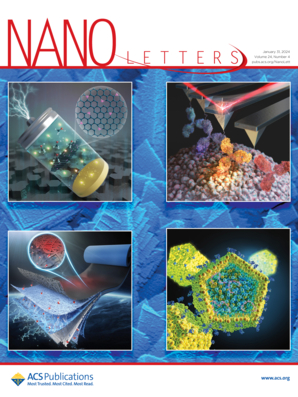Targeting Intracellular miRNA in Different Cancer Cell Models Using Gold Nanoprobes and Combined Mass Cytometry and Single Particle ICP-MS.
IF 9.6
1区 材料科学
Q1 CHEMISTRY, MULTIDISCIPLINARY
引用次数: 0
Abstract
DNA-conjugated gold nanoparticles (AuNPs) were developed to target intracellular miRNA-16-5p across various cancer cell models by base pair complementarity. The Au-nanoprobe uptake was addressed by multiparametric mass cytometry (CyTOF) monitoring iridium and gold, enabling discrimination among Au nanoprobes in intact cells and cellular debris. Our findings reveal significantly higher incorporation in lung cancer (A549) and melanoma (A375) cells compared to hepatic (HepG2) and ovarian (A2780) models with particle numbers ranging from 200 to 1 AuNPs per cell, respectively. The internalized Au nanoprobes targeting miR-16-5p were captured by mixing the lysed cells with a half-complementary DNA probe immobilized on streptavidin-coated magnetic microparticles. By counting the Au events in the captured solution is possible to quantitatively assess the concentration of miR-16-5p on each cell line. Together, these two complementary MS-based strategies establish a platform for the quantitative evaluation of nanocarrier-mediated miRNA targeting, offering new avenues for the development of miRNA-based cancer therapeutics.利用金纳米探针、结合细胞计数和单颗粒ICP-MS技术靶向不同肿瘤细胞模型中的细胞内miRNA。
通过碱基对互补,开发了dna共轭金纳米颗粒(AuNPs)靶向多种肿瘤细胞模型中的细胞内miRNA-16-5p。通过监测铱和金的多参数质量细胞术(CyTOF),可以区分完整细胞和细胞碎片中的金纳米探针,从而解决了金纳米探针的摄取问题。我们的研究结果显示,与肝细胞(HepG2)和卵巢细胞(A2780)模型相比,肺癌(A549)和黑色素瘤(A375)细胞中的掺入量显著增加,每个细胞的颗粒数分别为200至1 AuNPs。通过将裂解细胞与固定在链霉亲和素包被磁性微粒上的半互补DNA探针混合,捕获靶向miR-16-5p的内化Au纳米探针。通过计算捕获溶液中的Au事件,可以定量评估每个细胞系上miR-16-5p的浓度。总之,这两种互补的基于ms的策略建立了一个定量评估纳米载体介导的miRNA靶向的平台,为开发基于miRNA的癌症治疗方法提供了新的途径。
本文章由计算机程序翻译,如有差异,请以英文原文为准。
求助全文
约1分钟内获得全文
求助全文
来源期刊

Nano Letters
工程技术-材料科学:综合
CiteScore
16.80
自引率
2.80%
发文量
1182
审稿时长
1.4 months
期刊介绍:
Nano Letters serves as a dynamic platform for promptly disseminating original results in fundamental, applied, and emerging research across all facets of nanoscience and nanotechnology. A pivotal criterion for inclusion within Nano Letters is the convergence of at least two different areas or disciplines, ensuring a rich interdisciplinary scope. The journal is dedicated to fostering exploration in diverse areas, including:
- Experimental and theoretical findings on physical, chemical, and biological phenomena at the nanoscale
- Synthesis, characterization, and processing of organic, inorganic, polymer, and hybrid nanomaterials through physical, chemical, and biological methodologies
- Modeling and simulation of synthetic, assembly, and interaction processes
- Realization of integrated nanostructures and nano-engineered devices exhibiting advanced performance
- Applications of nanoscale materials in living and environmental systems
Nano Letters is committed to advancing and showcasing groundbreaking research that intersects various domains, fostering innovation and collaboration in the ever-evolving field of nanoscience and nanotechnology.
 求助内容:
求助内容: 应助结果提醒方式:
应助结果提醒方式:


